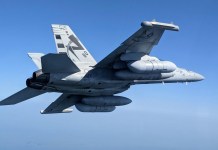On Friday night (March 18), an unmarked military convoy carrying “up to six” nuclear warheads passed through Glasgow amid rising tensions over Russia’s invasion of Ukraine, Glasgow Live reported.
The convoy was tracked from the M6 motorway near Kendal, Cumbria, to the M74 at Lesmahagow, about 25 miles south of Glasgow, before arriving at Royal Naval Armaments Depot Coulport (RNAD) on Loch Long at around 11:30 p.m on Saturday.
The Convoy’s route was a pretty common one, given it has been much traversed by UK defense vehicles. Interestingly, it is also where Trident nuclear missiles were spotted in May 2021, as per Glasgow Live.
According to NukeWatch, the convoy is thought to have traveled west on the M74 through Glasgow’s south side before merging with the M8 south of the Kingston Bridge. It then proceeded on the A82, a major road in Scotland, crossing the Erskine Bridge.
Reminder of the UK's contribution to nuclear terror. Yesterday a warhead convoy travelled all the way from Berkshire to the bomb store at Coulport on Loch Long, pic.twitter.com/hTFgw9hIiO
— Nukewatch (@NukewatchUK) March 19, 2022
NukeWatch is an organization that tracks and monitors the convoys that transport the UK’s Trident nuclear warheads. Nukewatch UK Campaigner Jane Tallents told Glasgow Live: “We think that’s the most likely [route] at that time of night. And looking at the timings of it I would say yes that’s probably what it did, took the M74 onto the M8 over the Erskine Bridge and up the A82 at Loch Lomondside.”
“I know it was about 11.30 pm last night that it got into [RNAD] Coulport. I think there were four warhead carriers I believe. Our reckoning is that each of those trucks can carry two but one of the trucks is empty as a spare in case breaks down. So if there’s four we expect there to be six warheads, or up to six warheads anyway”.
Rising Nuclear Threat
The news comes as Russia’s nuclear missiles have been placed on high alert as a result of Vladimir Putin’s invasion of Ukraine, which analysts fear would lead to nuclear-armed NATO states like the United Kingdom clashing with the Kremlin.
Moreover, on Sunday, Russian President Vladimir Putin shocked everyone by ordering military leaders to prepare for a “doomsday” nuclear evacuation scenario. The simulation entails military commanders evacuating Kremlin leaders and the Russian Federation leader aboard modified “doomsday” nuclear impact-resistant planes in the event of nuclear warfare.

NukeWatch said that the UK’s nuclear weapons transportation through the route is “routine.” However, considering Russia’s current invasion of Ukraine, the timing is “alarming.”
“There hasn’t been one since October last year which is a bit strange. But there was a bit of a flurry in the end,” said Tallents. “There must be some reasoning in their madness but they’d never enlighten us [as to] what that is.”
The aim of the nuclear movement, according to Nukewatch, was most likely refurbishment, not an attempt to arm the warheads in preparation for a Russian strike. “I don’t think this convoy is of any more concern than the fact that we are always, 24/7, armed and ready to start a nuclear war,” Tallents stated.
“All the things that some of us have worried about constantly since the 60s, they come to pass really. People have forgotten about it but they are there,” he added. The United Kingdom appears to be preparing for changing geopolitical realities.
The UK Ministry of Defence recently advertised for a position of a chief to supervise the threat of nuclear warheads, describing the current geopolitical atmosphere as a ‘genuinely exciting time’. The £40,000-a-year role at the Defence Nuclear Organisation is primarily concerned with ‘threats across the nuclear spectrum.’
Incidents Took Place on the same Route
In April 1973, a nuclear near-miss involving an unusual traffic accident took place at the Royal Naval Armament Depot Coulport. A Scottish Electricity Board Land Rover collided with an RAF nuclear weapon load carrier transporting nuclear warheads near the Coulport site in April 1973.
The vehicle was equipped with three UGM-27 Polaris missiles, each capable of delivering three ET.317 thermonuclear warheads. The load carrier was damaged in the incident, but the nuclear weapons remained in place.

In a separate occurrence at the same location in 1977, a Polaris missile fell while being hauled during realignment. In August 1983, an RAF nuclear weapons carriage carrying two warheads collided with a private automobile on the M8 near Glasgow.
Another close call occurred in 2009 when the British submarine HMS Vanguard collided with a French nuclear submarine, causing damage but no radiation leaks. Since 1966, there have been seven nuclear-related mishaps involving British weapons. However, there have been no radioactive leaks as of yet.
- Contact the author at ashishmichel@gmail.com
- Follow EurAsian Times on Google News




